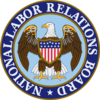Election Protection Rule
On August 12, 2019, the National Labor Relations Board published a Notice of Proposed Rulemaking (NPRM) proposing three amendments to the representation election regulations located at 29 CFR part 103 to better protect employees' statutory right of free choice on questions concerning representation. The amendments remove unnecessary barriers to the fair and expeditious resolution of such questions through the preferred means of a Board-conducted secret-ballot election under the National Labor Relations Act. Specifically, the NPRM proposed revisions to three of the Board's discretionary bars to the timely processing of a validly supported election petition: the blocking charge policy, the immediate imposition of a voluntary recognition bar, and the contract bar created by the establishment of a Section 9(a) relationship in the construction industry based solely on contract recognition language.
On April 1, 2020, the Board issued its final rule on these matters. The final rule includes some changes and clarifications from what was proposed in the NPRM. Due to the ongoing national emergency caused by the coronavirus, the Board has postponed the effective date 60 days. As published in the Federal Register today, the new effective date is July 31, 2020. These changes are summarized in the Election Protection Final Rule Fact Sheet below.
![]() Election Protection Final Rule Fact Sheet
Election Protection Final Rule Fact Sheet
![]() Election Protection Final Rule Press Release
Election Protection Final Rule Press Release
![]() Election Protection Rule Small Entity Compliance Guide
Election Protection Rule Small Entity Compliance Guide
Below are the appendices for both the majority and dissent regarding the NPRM's proposed amendments to the Board's blocking charge policy.
Majority Appendix A analyzes data regarding petitions that proceeded to an election in FY 2016, FY 2017, and FY 2018, similar to the study done by Professor Samuel Estreicher. See Samuel Estreicher, Improving the Administration of the National Labor Relations Act Without Statutory Change, 5 FIU L. Rev. 361, 369-370 (2010).
In consultation with the Board’s Office of the Chief Information Officer, the Board obtained the spreadsheets in Majority Appendix B to ascertain the number of petitions that were blocked (and for how many days) prior to the holding of an election in Fiscal Years 2016, 2017, and 2018 and the total number of pending petitions that remained blocked and for which no election had been held as of December 31, 2018.
This document includes Member McFerran’s attempt to assemble and analyze a reliable list of the FY 2016- and FY 2017-filed RD, RC, and RM petitions that were blocked pursuant to the blocking charge policy, independent of the data relied upon by her colleagues or provided to the public in the past. It also includes charts from the agency’s website showing the numbers of petitions filed during those two fiscal years and a comparison of the total RD, RC, and RM petitions filed during 12-year period with the Majority’s asserted number of blocked petitions pending as of December 31, 2018.
Press Release (August 9, 2019)


